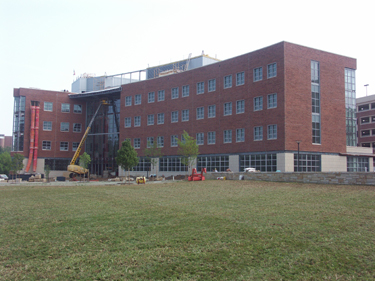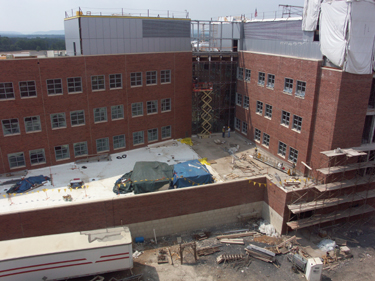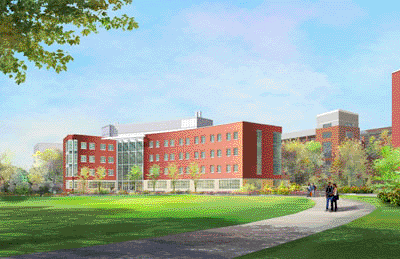Welcome to Chris Hoyman's AE Senior Thesis e-Portfolio
Building Statistics
Building Name: The School of Forest Resources Building
Location and Site: The Pennsylvania State University, University Park, Pennsylvania
Building Occupant Name: Penn State School of Forest Resources
Occupancy: Multi-use building, including classroom, offices,
administration, laboratories,
and an auditorium
Size: 92,000 gross square feet
Stories: 4 usable stories above ground plus a penthouse
for mechanical spaces on roof, 1 basement level,
6 total levels
Project Team:
Owner: The Pennsylvania State University
Construction Manager: Gilbane Building
Company
http://www.gilbaneco.com/home.aspx
Architect: Bower Lewis Thrower Architects
http://www.blta.com/
Structural and Civil Engineer: Gannett
Fleming
http://www.gannettfleming.com/
MEP: Bard, Rao, and Athanas
http://www.brplusa.com/
Landscape Architect: Lager Raabe Skafte
Landscape Architects
No website available
Telecom: Cerami and Associates
http://www.ceramiassociates.com/
Construction Dates: October 2004-May 2006
Total Project Cost: $27,000,000
Project Delivery: Design-Bid-Build (see Construction
section for more info)
Building System Information:
 Architecture:
Architecture:
The School of Forest Resources building along with the new Smeal business building works to create an architectural border along Park Avenue. The two buildings frame a large open pedestrian area which welcomes people into the University. The defining feature of the buildings exterior is the large atrium area, enclosed by a glass wall on the Park Avenue side.
Codes:
IBC 2000
Pennsylvania Code- Title 34 Labor and Industry 1996
Assorted MEP codes- NEC 2002, etc.
Zoning:
Zoned according to the Borough of State College University Planned District (UPD-5)
History:
Formerly a Pennsylvania State University parking lot
 Envelope:
Envelope:
The envelope of the School of Forest Resources building includes a curtain wall system and a flat roof. For the base layer of the wall, alternating sections of large and small cast stone were used. Recessed metal fascia separates this stone layer from the brick which rises to the top of the building. The brick wall is capped by a stone coping. The penthouse is surrounded by insulated metal paneling.
Glazing is 1” thick and insulated, with aluminum framework. On the east elevation of the building, sections of glazing are separated by lightweight limestone paneling with metal studs and insulation behind. These panels, along with the bricks, are held in place by galvanized steel shelves attached to structural members.
The roofing system is supported by a steel deck. A membrane roof layer covers tapered insulation which sits on the steel. Several overhang areas are reinforced with concrete poured on the metal deck.
Construction:
The School of Forest Resources building was constructed according to PA Labor and Industry 50.11 Fire Resistive construction codes. The building is located on the site of a former parking lot, so no major demolition was required. Contracts were bid out to multiple prime companies on an individual system basis. Gilbane, the construction manager, acts as an extension of the University and manages all companies. 15 individual contracts were given out for the building, slated for completion in May 2006. The actual start date of construction will be provided soon. The total estimated project cost is $27,000,000.
Electrical:
The School of Forest Resources building is fed from an electric service and transformer provided by the user (PSU-OPP). The building’s power use is metered by the customer. Four sets of (4) 600 MCM wires feed the 480Y/277v 2000A 50 KAIC Main Distribution Switchgear (MDS). The MDS feeds a transient voltage surge suppression system (tvss). The MDS ground bus attaches to a 250 MCM ground wire which connects to another ground bus on the electrical room wall. This bus is connected to each water service, sprinkler service, telephone/data ground bus, and the building counterpoise outside.
In the case of an emergency, two automatic transfer switches are feed from the MDS. The first ATS is connected to emergency/standby power feeds downstream of a 4160V 480/277V dry-type 45 kVA transformer. This ATS is 480/277V, 200A and feeds the Life Safety Panel. This panel feeds all life safety loads in the building for emergencies, including fire alarm panels. The second ATS is downstream of a 4160V 480/277V dry-type 112.5 kVA transformer connected to emergency/standby power feeds. This ATS powers a lab equipment load emergency panel.
The MDS directly feeds two other panels. The first is a 480/277V, 400A, 50KAIC distribution panel. The second is a 480/277V, 800A, 50KAIC panel. Additionally, two cable tap boxes are fed from the MDS. One attaches to a 480/277V 400A bus duct that serves additional panels. The second connects to a 480/277V 600A bus duct that also serves panels.
Ten step-down transformers are used throughout the building to feed 208/120V panels. These supply power to various loads, including receptacles, fire-alarm panels, fumehoods, etc.
Lighting:
The School of Forest Resources building is lit predominately with fluorescent fixtures operated at 277V. Typical classrooms have 2’ x 2’ U-Tube fixtures, with track mounted accent lighting for the podium areas. Conference rooms have pendant mounted linear fluorescent central lighting with recessed downlight accents around the perimeter. The atrium area is lit with recessed downlights. In the auditorium, linear fluorescent fixtures are used on the ceiling, with recessed stair lighting built into the steps.
Occupancy sensors are located in all offices as well as storage areas and equipment spaces. Classrooms are not equipped with occupancy sensors.
Structural:
The structural system in the School of Forest Resources building is a steel frame construction. For the unexcavated portion of the site, a 6” slab on grade concrete floor was poured. All other floors use slab on steel decking, usually 5-1/2” thick on all floors. Typical beam sizes for the floors include W12x22, W16x31, and W16x36 with spacing ranging between five and eight feet. A typical bay area measures 20’ by 36’.
The building’s flat roof system is supported by W12x26 beams. For the atrium ceiling and overhang, 8-3/4 x 36” glulam beams were used for support. The penthouse roof is typically supported by W12X22 beams. All exterior walls are curtain wall systems.
Mechanical:
The Forest Resources Building relies on the Penn State University campus steam and chilled water networks for heating and cooling. Steam from the campus system enters into the building on the east side. Two steam-water heat exchangers located in the basement of the building provide hot water. Eight hot water pumps are used to transport the water throughout the building. This water provides heating via radiant panels as well as enclosed fin-tube radiators. Campus steam is also utilized by the air handling units on the roof for preheating and humidification.
Chilled water from the campus loop services building cooling needs. Two plate and frame heat exchangers, located in the ground floor mechanical room, are used to provide cold water. Two pumps are used to transport this water throughout the building. An additional two pumps push chilled water to the air handling units on the roof of the building for cooling.
The building air supply is furnished by three air handling units located on the roof. Two 40,000 cfm units provide air to the non-lab areas of the building, including offices, conference rooms, and the atrium. 14,000 cfm of outdoor air is provided by each of these air handlers. One 54,000 cfm air handler provides 100% fresh outdoor air to the lab areas at all times. The building uses both variable are volume and controlled air volume boxes throughout to disperse air. The main building exhaust fans are located centrally in the building atrium and pull 22,500 cfm each. Additional air is exhausted from the building by eight fan units. These fans remove air from fumehoods in various lab areas.
Fire Protection:
The firewater system in the School of Forest Resources building is feed from a pipe on the east side of the building. The pipe enters into the basement floor mechanical room. The sprinkler system is an automatic wet type with a 0.15 gpm spray density. Standpipes are located in Stairwell #1 and the wood products teaching lab beneath it, as well as Stairwells #2 and #3. Another access point for the fire department is located inside the mechanical room. Two of the standpipes penetrate the roof and are capped by free standing roof hydrants. Fire alarms pull stations, and horns are located according to code (International Fire Code 2000). The building is ADA compliant and resistance ratings for walls are based on PA Labor and Industry Fire Resistive Construction code (50.11). The atrium has a fire alarm interface module at the exterior doors which interfaces with the system to open the doors automatically if the atrium smoke control systems activate.
Plumbing:
The School of Forest Resources potable and non-potable water pressure is maintained by a main booster pump located in the basement. Hot water is provided by 3 steam-water heat exchangers. Additional water circulation pumps are located with these heaters. Normal waste and ventilation piping is provided, as is separate piping for lab waste and ventilation. A vacuum system runs through all floors and is serviced by a vacuum pump located in the basement. Gas and lab air piping is provided on all levels. An area of special consideration for water piping is the aquaculture lab and aquarium rooms. Each aquarium is furnished with its own water supply.
Telecommunications:
The main telecommunications room and main server room for the School of Forest Resources building are both located on the second floor. Telecommunications services and the connection to the campus network enter in the basement. The main risers are fiber optic and feed the telecom room. Ceiling mounted cable trays route cable throughout all floors. A central riser area houses conduits that carry wires to every level. 4” conduit sleeves are provided for each conduit at the floor penetrations. Data/telephone jacks are located throughout the building, particularly in offices, and are feed by CAT6 and coax cables. High concentrations also occur in the CAC labs in the basement and on the fourth floor as well as the tele/video conference room on the second floor. Hubs are also located in labs and student areas to provide wireless internet access.
Transportation:
The School of Forest Resources building contains three elevators, two for
passenger circulation and one service elevator. The passenger elevators
are located centrally in the building’s atrium and serve the basement
to fourth floors. The service elevator is located on the south side of the
building near the loading dock and accesses all levels including the penthouse.
The elevators are powered by three 50 hp motors located in the elevator
machine rooms. The machine rooms for the passenger elevators are located
on the penthouse level. The service elevator machine room is located on
a higher section of the penthouse to accommodate access to the level from
the elevator.
Special Systems:
No further special systems have been identified.
